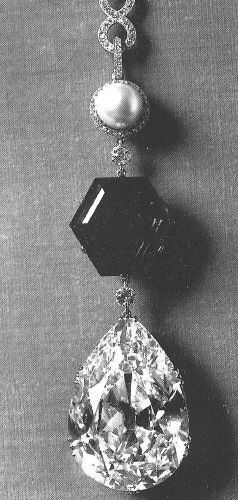The Curse of the Hope Diamond
- tsarinagems
- Apr 8, 2021
- 4 min read
Described as the most famous diamond in the world, the Hope Diamond truly is one of a kind and over the centuries has been on quite a journey.
The stunning 45 carat blue diamond did not always look like the exquisite necklace on display at the Smithsonian Institution today. It has been recut several times, featured in multiple jewellery pieces, has been on several adventures and went through the hands of many owners, know and unknown.
Did you know that it also carries a heavy burden of being cursed?
Let's take a closer look at this notorious gem and its turbulent past.

Where did the Hope Diamond come from?
The jewel was first discovered in India, in the 17th century. The extraordinary gem was formally named Tavernier Blue, after a French gem merchant who purchased it in India. At the time, it was triangular in shape, approximately 112 carat in weight. It was then sold to Louis XIV in 1668, recut to 67 carat and given a new name, the French Blue. During the French Revolution (1789-1799) it was stolen, once again recut to disguise its identity and reappeared in London, England in 1812. It has been suggested that at some point, the Hope Diamond belonged to King George IV of England and was later sold through private channels to pay off a large debt.

How did the Hope Diamond get its name?
Its cheerful name actually comes from the Hope family, London bankers that owned this magnificent gem in the 1830s (interestingly, it is still not clear as to how they came to have it in their possession). However, many of those who owned or even came close to the gem have suffered terrible fates and financial troubles. Consequently, it was believed to be cursed. It once belonged to Marie Antoinette and Louis XVI (below) and was a part of the French Crown Jewels and we all know how that ended!

Who was the next lucky owner?
In 1910, Pierre Cartier, grandson of Louis-Francois Cartier, founder of the Cartier jewellery brand, made the decision to purchase this unique gem, the size of a walnut, from a jewel merchant.
The next “lucky” owner of this marvellous gem was an American mining heiress and a socialite, Evalyn Walsh McLean, who adored and collected gems. When she was 12 years old, her father, Thomas Walsh (an Irish immigrant) discovered a gold mine and became a multimillionaire.

Evalyn did not care for the original Cartier piece in which the jewel was set, so another Cartier masterpiece was made and she fell in love with it. The power couple of the time, Evalyn and her husband, Edward "Ned" Beale McLean (an heir to The Washington Post), purchased the Hope Diamond for the price of $180,000, approximately
$5 million today. Evalyn even took it to church for a blessing and wore it as a good luck charm. She never missed an opportunity to flaunt it and even tied it to the neck of her dog, a Great Dane called Mike, imagine that!

Interesting, the McLean family traded in another spectacular gem from their collection to pay for the Hope. The necklace below featured an impressive pear shape diamond weighing 94.78 carat known as the Star of the East. The hexagonal emerald above the diamond was later traded in for the Hope. In 2017, the 34 carat Stotesbury emerald was sold at a Sotheby's auction for $1million.
Stay tuned for the story of the Stotesbury emerald coming in May, the month of emeralds!

What about the curse?
Evalyn kept the Hope Diamond for the rest of her life, and although never publicly admitted to believing in the curse, she suffered several tragedies. Her husband left her for another woman and she lost two of her four children (her young son was killed in a car accident, and her daughter died of a drug overdose). Her family newspaper, the Washington Post went bankrupt. In 1947, she died of pneumonia at the age of 60, and was the last private owner of the cursed jewel.

Where is the Hope Diamond now?
In 1949, the Hope Diamond was purchased by Harry Winston. In 1958, he donated it to the Smithsonian Institution in Washington, where it has been on display ever since. It has become one of the most popular exhibits and famously arrived to the museum by registered mail, insured for $1 million, its value is now estimated at $350 million.
Although at one point the Hope Diamond was displayed as a loose stone, it is currently on display as a part of a magnificent necklace.

The Hope Diamond was never formally graded until it was assessed by members of Gemological Institute of America (GIA) in 1988, as a loose stone, at the Smithsonian.
Here are some fun facts from the grading report:
Weight: 45.52 carat
Measurements: 25.60 x 21.78 x 12.00 mm
Clarity: VS1
Colour: Fancy Dark Greyish Blue (It contains a trace element called boron, which gives the gem its rare blue colour)
Shape and cut: Antique cushion brilliant cut (this typically resembles an elongated, rather than a square cushion)

To find out more about diamonds and how they are graded, check out my previous post Happy Birthday, Diamond!
The Hope Diamond is an extraordinary gem with an incredible story to tell and is definitely on my bucket list to see in person!
Stay tuned for more stories on the world's most remarkable jewels!
For any questions or requests, do get in touch with me via Tsarina Gems Homepage
Visit my Gallery for more inspiration
Check out my Instagram page for jewellery ideas
コメント